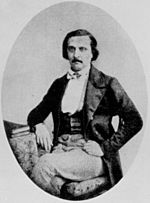Charles Frédéric Gerhardt facts for kids
Quick facts for kids
Charles Frédéric Gerhardt
|
|
|---|---|

Charles Frédéric Gerhardt
|
|
| Born | 21 August 1816 |
| Died | 19 August 1856 (aged 39) Strasbourg
|
| Nationality | French |
| Known for | Notation for chemical formulas |
| Scientific career | |
| Fields | Chemistry |
Charles Frédéric Gerhardt (born August 21, 1816 – died August 19, 1856) was an important French chemist. He was born in Alsace and worked in Paris, Montpellier, and his hometown of Strasbourg.
Life Story of Charles Gerhardt
Charles Gerhardt was born in Strasbourg. He went to a special high school there called a gymnasium. After that, he studied at the Karlsruhe Institute of Technology. There, he became very interested in chemistry because of lectures by Friedrich Walchner.
Later, he went to a business school in Leipzig. He studied chemistry with Otto Linné Erdmann. This made his interest in chemistry even stronger. He loved thinking about new ideas in chemistry.
In 1834, Charles went back home to work in his father's factory. They made a white paint called white lead. But Charles didn't like the business world. He had a big argument with his father when he was 20. So, he joined the army as a cavalry soldier.
However, army life wasn't for him either. After a few months, he bought his way out of the army. A German chemist named Justus von Liebig helped him. After a short time in Dresden, Charles went to the University of Giessen in 1836. He studied and worked in Liebig's lab for about 18 months.
In 1837, he tried working in his father's factory again. But he argued with his father once more. So, in 1838, he moved to Paris. Liebig had given him letters to introduce him to important people there.
In Paris, Charles went to lectures by Jean Baptiste Dumas. He also worked with Auguste Cahours in Michel Eugène Chevreul’s lab. They studied essential oils, especially from cumin. To make money, Charles taught and translated some of Liebig's writings.
In 1841, thanks to Dumas, Charles became a chemistry professor in Montpellier. He became a full professor in 1844.
In 1842, he upset some friends in Paris with his ideas about how to group organic compounds. He later published a book called Précis de chimie organique (1844–1845). In 1845, Liebig criticized him. Even though they made up in 1850, Charles often disagreed with his friends. This made it hard for him to find new jobs after he left Montpellier in 1851. He didn't want to move far from Paris.
Charles took time off from Montpellier in 1848 to focus on his research. He lived in Paris until 1855. During this time, he started a "School for practical chemistry." He had high hopes for it, but things didn't work out as he wished.
In 1854, he was offered a job at a new school in Zürich, but he said no. In 1855, he accepted a chemistry professor job in Strasbourg. He worked at the Faculty of Sciences and the École Polytechnique there. He died the next year, in 1856. He had just finished checking the last part of his most important work, Traité de chimie organique (4 volumes, 1853–56). This big book contained all his ideas and discoveries.
What Charles Gerhardt Discovered
Gerhardt is famous for changing how we write chemical formulas (from 1843–1846). He also worked on special chemical compounds called acid anhydrides. He even made acetylsalicylic acid, which is the main ingredient in aspirin. However, his version was not very stable or pure.
Charles Gerhardt is often remembered alongside his friend Auguste Laurent. They both had strong and important ideas about how chemicals combine.
A rare mineral called gerhardtite is named after him.
His Death
Charles Gerhardt died on August 19, 1856, from a sudden fever. He was just two days short of his 40th birthday.
See also
 In Spanish: Charles Frédéric Gerhardt para niños
In Spanish: Charles Frédéric Gerhardt para niños

